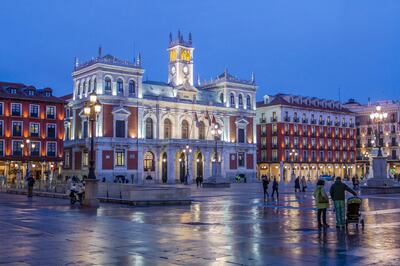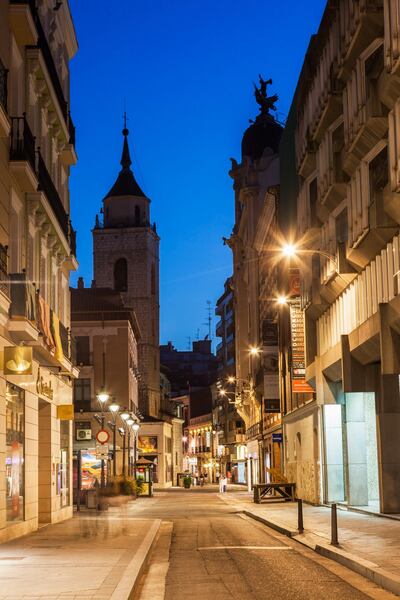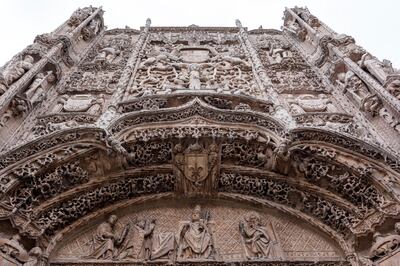Why Valladolid?
Spain is a difficult beast to get a handle on – partly because there are so many different versions of it. Andalusia has the fabulous Moorish architecture, Catalonia an edge that hankers to be part of northern Europe, and the Basque Country a feisty, independent pulse.
In the middle of that, however, is a more reserved, refined High Spain. It’s the Spain of royalty, carefully elegant architecture and roasted meats. And Valladolid comes across as the embodiment of this.
More to the point, it does so while being almost entirely ignored by foreign visitors. And that under-the-radar factor, coupled with it being only an hour from Madrid by high-speed train, forms an immense part of the appeal. Once home to the royal court, Cervantes and Columbus, Valladolid has the good looks and the heritage, but manages to feel quintessentially Spanish without being diluted by tour bus crowds.
A comfortable bed
A fair way out of the city centre, but with its own indoor pool and steam room, the AC Hotel de Palacio Santa Ana (www.marriott.com) is an old monastery that has been rather delightfully converted. Rooms have dark wood floors, and many original features have been kept. Prices start at €75 (Dh322).
The 39-room Atrio hotel (www.hotelesvalladolid.com) is arguably the most appealing place to stay in the city centre. Spotlessly clean with large burgundy draped curtains and stone-tiled floors, the rooms look good and are available for from a bargain €64 (Dh275).
Locationwise, the Hotel Mozart (www.hotelmozart.net) is tough to beat. On the cusp of the old town and easily walkable from the train station, it's a little business bland inside the grand 18th century building, but it provides a perfect base for exploration. Expect to pay from €60 (Dh258).
Find your feet
The first stop should be the tourist information office in the large, often quirkily decorated and triangular Campo Grande park. The ladies behind the desk should be able to furnish you with armfuls of lightly themed walking route brochures.
Nearby is the Casa de Cervantes (www.mecd.gob.es/museocasacervantes), where Spain's most celebrated author – Miguel de Cervantes – lived between 1551 and 1553. Now a museum, it explores Cervantes's rather eventful life (which includes being held captive for five years in Algiers) and the impact Don Quixote had on world literature.
From there, head towards the Plaza Mayor, one of Spain’s finest focal squares. It’s surrounded by four-to-five storey buildings, all painted in earthy reds and boasting dainty balconies. The town hall, with an elegant clock tower stands in the middle.

Valladolid is one of those cities that is marvellously enjoyable to amble directionlessly through, but the end destination should be the Casa Museo de Colon (www.valladolid.com/casa-museo-colon). If you speak Spanish, this is an excellent museum about Christopher Columbus, his voyages to the Americas, and the political backdrop that made it possible. For non-Spanish speakers, a fair amount is conveyed through maps and imagery, but the finer details will be missed.
Meet the locals
The riverside parks are where the locals head to get a bit of fresh air and headspace. And, should they require a decent stroll, the waterside towpath does the trick.
Book a table
If you want to go traditional, La Parrilla de San Lorenzo (www.laparrilladesanlorenzo.es) is the winner. It dates back to the 16th century, with painted ceilings, brick arches and oil paintings all over the walls. To have anything other than the €17.95 (Dh77) lechazo – roast, suckling lamb – would be a dereliction of duty.
For something more 21st century, Villa Paramesa (www.villaparamesa.com) serves up award-winning tapas that don't stick slavishly to old Spanish standards. For example there's mackerel with yuza and seaweed, as well as a sardine ceviche rendition with black garlic. Most cost around €3 (Dh12) each.
Shoppers’ paradise
Much of the city centre is pedestrianised and lined with shops. Santiago is one of the main streets, with a variety of largely mid-range shops. These include Blanco, which specialises in affordable Euro-chic womenswear, while Bimba Y Lola offers chunky jewellery, leather handbags and fur coats.

What to avoid
If dropping in from Madrid, make sure you get the fast train tickets. The slow trains may cost slightly less, but they take three times as long.
Don’t miss
Step beyond the dramatic and almost cartoonishly detailed facade of the Colegio de San Gregorio, and you enter the wonderful Museo Nacional de Escultura (www.mecd.gob.es/mnescultura). This is full of sculptures and wood carvings purloined from chapels, churches and monasteries, with the detail on some of the works quite staggering.

Essentially, this is the equivalent of an old masters art museum, but for people who chipped away at trees rather than put oil on canvas. The craftsmanship on display leaves you thinking “how on earth did they manage to do that?”.
Getting there
Emirates (www.emirates.com) and Etihad (www.etihad.com) fly direct to Madrid from Dubai and Abu Dhabi respectively. Economy class returns cost from Dh2,980. High speed trains (www.renfe.com) from Madrid's Chamartin station to Valladolid take around 65 minutes and cost from €46.40 (Dh199).





